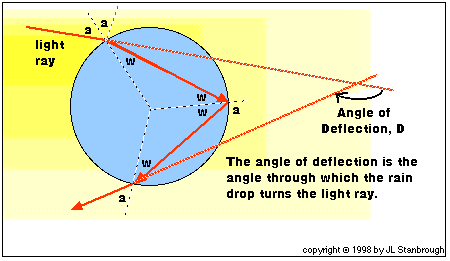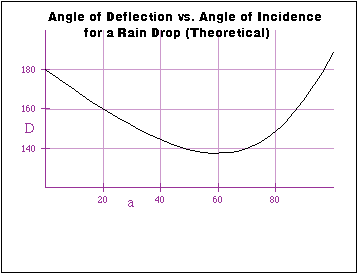Rainbows
![[Prev]](../../NavIcons/Prev.GIF)
![[Up]](../../NavIcons/Up.GIF)
![[Home]](../../NavIcons/Home.GIF)
![[Help]](../../NavIcons/Help.GIF)
The Angle of Deflection:
The applet below allows you to "experiment" with the interaction
of a light ray and a rain drop. The white light ray enters the
raindrop on the left. The red and blue portions of this ray are
traced through the raindrop. You can move the light ray by clicking
and/or dragging your mouse on the left side of the applet.
The table below the rain drop shows the angles of incidence and
refraction for each color, as well as the angle of deflection for the
ray. (The angle of deflection is the angle between the original
direction of the light ray and its direction after striking the rain
drop.)
As you move the light ray, observe the effect of the incident
angle on the dispersion of the red and blue rays as well as the
effect of the angle of incidence on the angle of deflection. (You can
find another virtual experiment similar to this one at
Circles
of Light - The Mathematics of Rainbows.)
The angle through which the rain drop turns the light ray is
called the angle of deflection for the ray. As the diagram below
shows, the angle of deflection depends on the angle at which the
light ray strikes the drop.

The Rainbow Angle
If you graph angle of deflection vs. angle of incidence (from data
collected in a virtual (or real!) experiment, or graph the function
derived in the last section, you can clearly see that there is a
minimum angle of deflection of approximately 138o
(depending on color). This may ring a bell, since
138o is the supplement of 42o, the "rainbow
angle" (sometimes called the "Descartes angle"). Why does this
minimum value correspond to the angle at which you view a rainbow?
- Notice, from the graph, that a fairly-wide range of angles of
incidence produce an angle of deflection very near
138o, so a fairly-large proportion of the incoming
sunlight is concentrated in a beam of light leaving the rain drop
at about 138o. For other angles of incidence, the
angles of deflection are more spread out.
- Notice, from the applet, that larger angles of incidence (near
the angle producing the minimum deflection) cause more dispersion
of the red and blue rays than small angles of incidence.
- The angle at which a light ray strikes a boundary determines
the proportion of the ray that is reflected and the proportion
that is transmitted. Rays that strike the back of the rain drop at
a small angle will reflect a smaller proportion of the ray (more
will be transmitted) than rays that strike the back of the
raindrop at a larger angle (near the angle that produces the
minimum deflection.
 So,
rays that strike the rain drop at an angle of incidence near the
angle producing the minimum angle of deflection will tend to form a
concentrated, strong beam in which the colors will be widely
separated. Rays that strike the rain drop at a small angle of
incidence will tend to pass through the drop, and the part of the
rays that are reflected inside the drop are spread out relative to
one another, while the colors within the rays are not noticeably
separated.
So,
rays that strike the rain drop at an angle of incidence near the
angle producing the minimum angle of deflection will tend to form a
concentrated, strong beam in which the colors will be widely
separated. Rays that strike the rain drop at a small angle of
incidence will tend to pass through the drop, and the part of the
rays that are reflected inside the drop are spread out relative to
one another, while the colors within the rays are not noticeably
separated.
What Next?
Well, surely this explains everything there is to know about
rainbows! Not so fast, bud. The rainbow is an extremely rich
phenomenon, and we have just scratched the surface. There are several
couple of features of the rainbow that can be explained by simple ray
optics - here are some hints...
- Double
rainbows are often observed. Where does the second rainbow
come from?
- Hint: Part of the light ray remains inside the drop
when the light that forms the primary rainbow leaves the rain
drop. What is the angle of deflection for the ray that makes a
"second lap" around the drop? Is there a rainbow angle for this
ray? Does it correspond to the observed angle for the secondary
rainbow?
- The area of the sky between the the primary and secondary
rainbows is noticeably darker than the sky outside the rainbows.
Why?
- Hint: Compare the rainbow angles for the primary and
secondary rainbows. Are there any angles at which light will
not be deflected?
- Blue light is refracted through a larger angle than red light,
yet the outer margin of the primary rainbow is red, not blue. Why?
- The colors observed in the secondary rainbow are reversed from
the colors of the primary rainbow. Why?
Have fun!
References:
- Circles
of Light - The Mathematics of Rainbows - very interesting
series of pages on reflection, refraction, and dispersion of
light. The mathematics may be intimidating, but everyone should be
able to get something valuable from this site.
- About
Rainbows - Very nicely done - includes demonstrations &
experiments you can try, as well as further references.
- Physics
of Rainbows - features a Java applet that demonstrates the
path of a light ray through a spherical drop
- Carl B. Boyer, "Kepler's Explanation of the Rainbow",
American Journal of Physics 18, 360-366(1950)
- Jearl D. Walker, "Multiple Rainbows From a Single Drop of
Water and Other Liquids", American Journal of Physics 44,
421-433 (1976)
![[Prev]](../../NavIcons/Prev.GIF)
![[Up]](../../NavIcons/Up.GIF)
![[Home]](../../NavIcons/Home.GIF)
![[Help]](../../NavIcons/Help.GIF)
last update February 10, 1999 by
JL Stanbrough

 So,
rays that strike the rain drop at an angle of incidence near the
angle producing the minimum angle of deflection will tend to form a
concentrated, strong beam in which the colors will be widely
separated. Rays that strike the rain drop at a small angle of
incidence will tend to pass through the drop, and the part of the
rays that are reflected inside the drop are spread out relative to
one another, while the colors within the rays are not noticeably
separated.
So,
rays that strike the rain drop at an angle of incidence near the
angle producing the minimum angle of deflection will tend to form a
concentrated, strong beam in which the colors will be widely
separated. Rays that strike the rain drop at a small angle of
incidence will tend to pass through the drop, and the part of the
rays that are reflected inside the drop are spread out relative to
one another, while the colors within the rays are not noticeably
separated.